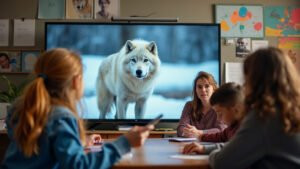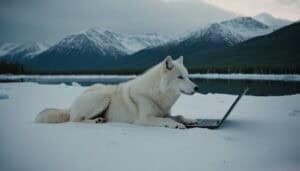Introduction
Zoos and wildlife centers play a crucial role in educating the public about Arctic wolves, their habitats, and the challenges they face in the wild. Through well-designed educational programs, interactive exhibits, and the expertise of dedicated zookeepers and educators, these institutions provide valuable insights into the lives of Arctic wolves
This article explores the various aspects of Arctic wolf education in zoos, from the development of educational programs to the effectiveness of these initiatives
Additionally, we will examine the challenges and future directions in this field, highlighting the importance of partnerships and innovative approaches in enhancing public understanding and conservation efforts
Educational Programs about Arctic Wolves in Zoos and Wildlife Centers
Educational programs about Arctic wolves in zoos and wildlife centers are designed to inform and engage the public about these fascinating animals
These programs aim to raise awareness about the Arctic wolf’s natural habitat, behavior, and the conservation efforts needed to protect them. By providing interactive and informative experiences, zoos play a vital role in educating visitors of all ages
Development of Arctic Wolf Educational Programs
The development of educational programs for Arctic wolves involves a meticulous process that includes research, planning, and collaboration with wildlife experts
Zoos often start by gathering comprehensive data on Arctic wolves, including their behavior, diet, and habitat requirements. This information is then used to create engaging and informative content tailored to different age groups and educational levels
For instance, the San Diego Zoo offers an Arctic Wolf Experience that includes behind-the-scenes tours, interactive displays, and educational talks by knowledgeable staff
These programs are designed to provide visitors with a deeper understanding of Arctic wolves and the challenges they face in the wild, such as climate change and habitat loss
To ensure the effectiveness of these programs, zoos often collaborate with conservation organizations and academic institutions. This collaboration helps in the development of accurate and up-to-date educational materials
For example, the Minnesota Zoo partners with the International Wolf Center to create educational programs that are both informative and scientifically accurate
Key Topics Covered in Arctic Wolf Education
Arctic wolf education programs cover a wide range of topics to provide a holistic understanding of these animals
Some of the key topics include:
Habitat and Distribution: Information about the Arctic tundra, the primary habitat of Arctic wolves, and how these wolves have adapted to such harsh environments
Behavior and Social Structure: Insights into the pack behavior of Arctic wolves, their hunting strategies, and social hierarchy within the pack
Diet and Hunting: Detailed information on what Arctic wolves eat, their hunting techniques, and their role as apex predators in the Arctic ecosystem
Conservation Status: Discussion on the current conservation status of Arctic wolves, including threats such as climate change, human encroachment, and loss of prey species
Role in the Ecosystem: Explanation of the ecological importance of Arctic wolves and how they help maintain the balance in their natural habitat
By covering these topics, zoos aim to provide a comprehensive education that not only informs but also inspires visitors to take an active role in conservation efforts
Interactive Exhibits and Activities
Interactive exhibits and activities are essential components of Arctic wolf educational programs. These hands-on experiences help engage visitors and make learning more enjoyable and memorable
Many zoos incorporate various interactive elements into their Arctic wolf exhibits, such as:
Touch Screens and Interactive Displays: These allow visitors to explore detailed information about Arctic wolves, their habitats, and conservation efforts through interactive maps, videos, and quizzes
Live Demonstrations: Some zoos offer live demonstrations where visitors can observe zookeepers feeding Arctic wolves and discussing their care and behavior
Educational Workshops: Workshops and classes for children and adults provide an opportunity to learn more about Arctic wolves through activities such as making wolf masks, tracking animal prints, and participating in mock wildlife research projects
Virtual Reality Experiences: Advanced technology like virtual reality can transport visitors to the Arctic tundra, giving them an immersive experience of the wolves’ natural environment and behavior
The Smithsonian’s National Zoo, for example, features an “Arctic Adventure” exhibit that includes interactive elements like a virtual reality journey to the Arctic and hands-on activities for children to learn about wolf tracking and behavior
These interactive experiences not only enhance learning but also foster a deeper connection between visitors and Arctic wolves, encouraging a greater commitment to wildlife conservation
Effectiveness of Arctic Wolf Education in Zoos
The effectiveness of Arctic wolf education programs in zoos is measured by their ability to inform, engage, and inspire the public
These programs aim to create awareness about Arctic wolves and encourage conservation efforts. Evaluating their success involves various methods and examining real-world case studies
Methods of Assessing Educational Impact
To assess the impact of educational programs, zoos use several methods. Surveys and feedback forms are common tools used to gauge visitor satisfaction and learning outcomes
These tools often include questions about the visitors’ knowledge before and after participating in the programs, as well as their enjoyment and engagement levels
For instance, the Woodland Park Zoo in Seattle conducts visitor surveys to measure the educational impact of their exhibits. These surveys help determine how much information visitors retained and whether their attitudes toward Arctic wolves and conservation changed positively
Another method involves observational studies, where researchers observe and record visitor interactions with exhibits and educational materials. This helps to identify which aspects of the programs are most effective in engaging the public
Zoos also use pre- and post-visit questionnaires to assess changes in knowledge and attitudes. These questionnaires are particularly effective for school groups and educational tours, providing measurable data on the program’s impact
Case Studies on Successful Education Programs
Examining successful case studies provides valuable insights into what makes an effective Arctic wolf education program
One notable example is the Toronto Zoo’s Arctic Wolf Exhibit, which includes interactive displays, educational talks, and a strong focus on conservation. The program’s success is evident in the positive feedback from visitors and the increased awareness about Arctic wolves
Another example is the Arctic Wolf Education Program at the Cincinnati Zoo, which offers a blend of live animal displays, multimedia presentations, and hands-on activities. The program has received high praise for its comprehensive approach to education, effectively engaging visitors of all ages
The Bronx Zoo’s educational initiatives for Arctic wolves include partnerships with local schools and community groups
Their outreach programs extend beyond the zoo, bringing educational materials and live demonstrations to classrooms and community centers. This broader approach has significantly increased public awareness and support for Arctic wolf conservation
Measuring the Impact of Arctic Wolf Education Programs
Measuring the long-term impact of Arctic wolf education programs involves more than just immediate feedback
Zoos often conduct longitudinal studies to track changes in visitors’ attitudes and behaviors over time. These studies help determine if the educational programs lead to sustained interest and involvement in conservation efforts
For example, the San Diego Zoo has implemented a longitudinal study to measure the long-term impact of their Arctic Wolf Experience. The study tracks participants over several years, assessing their ongoing engagement with conservation activities and their support for wildlife protection initiatives
Another effective method is the use of follow-up surveys sent to visitors months or even years after their visit. These surveys can provide insights into the lasting impact of the educational programs and identify areas for improvement
Zoos also collaborate with academic institutions to conduct research on the effectiveness of their educational programs. This collaboration often results in published studies that contribute to the broader understanding of wildlife education and conservation
Role of Zookeepers and Educators in Arctic Wolf Education
Zookeepers and educators play a pivotal role in Arctic wolf education by leveraging their expertise and passion to provide engaging and informative experiences for visitors. Their knowledge and dedication are key to effective wildlife education
Training and Expertise of Zookeepers
Zookeepers working with Arctic wolves undergo specialized training to understand the animals’ behavior, dietary needs, and habitat requirements. This training includes both theoretical knowledge and practical experience
For example, zookeepers at the Detroit Zoo participate in comprehensive training programs that cover wolf biology, ecology, and conservation. These programs often involve collaboration with wildlife biologists and conservationists to ensure that zookeepers have the most current and accurate information
Additionally, zookeepers frequently attend workshops and conferences, such as those organized by the Association of Zoos and Aquariums (AZA), to stay updated on the latest research and best practices in animal care and education
This continuous learning process enables zookeepers to provide visitors with the most relevant and scientifically accurate information about Arctic wolves
Educational Techniques Used by Zookeepers
Zookeepers and educators use a variety of techniques to convey information about Arctic wolves to the public effectively
These techniques include:
Interpretive Talks: Zookeepers often conduct live talks and demonstrations, where they share fascinating facts about Arctic wolves and answer visitors’ questions. These sessions are designed to be interactive, encouraging audience participation
Guided Tours: Many zoos offer guided tours led by knowledgeable staff. During these tours, visitors can observe Arctic wolves up close and learn about their behavior, social structure, and conservation status
Interactive Displays: Educators use interactive displays and multimedia presentations to engage visitors. These displays often include touch screens, videos, and sound effects that provide a multisensory learning experience
Storytelling: Storytelling is a powerful educational tool used by zookeepers to capture the imagination of visitors, especially children. By sharing stories about individual wolves and their experiences, educators can create a personal connection between visitors and the animals
Hands-On Activities: Zookeepers organize hands-on activities such as animal tracking workshops, where visitors can learn how to identify wolf tracks and other signs of their presence in the wild. These activities make learning fun and memorable
For instance, the Denver Zoo’s Arctic Wolf Program includes interactive educational sessions where visitors can participate in activities like making enrichment toys for the wolves, which are later given to the animals to stimulate natural behaviors
This hands-on approach not only educates but also fosters empathy and a deeper understanding of the wolves’ needs and behaviors
Challenges in Arctic Wolf Education at Zoos
Educating the public about Arctic wolves comes with several challenges. These challenges range from overcoming misconceptions about the species to dealing with resource constraints. Understanding these obstacles helps zoos improve their educational programs and maximize their impact
Overcoming Misconceptions About Arctic Wolves
One significant challenge in Arctic wolf education is addressing and correcting common misconceptions. Many people have limited knowledge about Arctic wolves, often confusing them with other wolf species or holding inaccurate beliefs about their behavior and ecological roles
For instance, a prevalent misconception is that all wolves are dangerous and pose a threat to humans
In reality, Arctic wolves are shy and avoid human contact. Zookeepers and educators work to dispel these myths by providing accurate information about wolf behavior and emphasizing their importance in maintaining the balance of Arctic ecosystems
Educational programs often include myth-busting sessions, where common misconceptions are discussed and corrected. These sessions might involve interactive quizzes or comparisons between myths and facts to engage visitors actively
Moreover, storytelling techniques, such as sharing real-life examples of positive human-wolf interactions, can be effective in changing perceptions. For example, educators might share stories of successful conservation efforts and how local communities coexist peacefully with wolves
Resource Constraints and Their Impact on Education
Resource constraints are another challenge that zoos face in providing comprehensive Arctic wolf education. Financial limitations can affect the quality and extent of educational programs, from staffing to the development of interactive exhibits
Many zoos rely on donations, grants, and government funding to support their educational initiatives. When funding is limited, it can be challenging to hire enough trained staff or invest in advanced educational tools and technologies
Additionally, zoos must balance their budgets across various departments, including animal care, facility maintenance, and educational outreach. This balancing act can sometimes lead to compromises in the quality or scope of educational programs
To overcome these constraints, zoos often engage in fundraising activities and seek partnerships with corporate sponsors and non-profit organizations. For instance, the Houston Zoo has partnered with local businesses and conservation organizations to secure funding for its Arctic wolf educational programs. These collaborations provide financial support and enrich the content and reach of the programs
Another strategy is to leverage volunteer programs. Many zoos have robust volunteer networks that assist with educational programs, providing tours, staffing interactive exhibits, and helping with special events. Volunteers, often trained by zookeepers and educators, play a crucial role in enhancing the zoo’s educational capacity
Despite these efforts, resource constraints remain a persistent challenge, requiring zoos to continuously innovate and seek new funding sources to sustain and improve their Arctic wolf education initiatives
Partnerships for Arctic Wolf Conservation Education
Partnerships are crucial for the success of Arctic wolf conservation education programs in zoos. Collaborations with wildlife organizations, academic institutions, and other stakeholders help zoos enhance their educational offerings and amplify their conservation messages
Collaborations with Wildlife Organizations
Zoos often collaborate with wildlife organizations to create comprehensive and impactful educational programs. These partnerships bring together expertise and resources that enhance the quality and reach of the programs
For example, the International Wolf Center (IWC) partners with various zoos to provide specialized educational content and resources about wolves, including Arctic wolves
The IWC offers workshops, training programs, and educational materials that zoos can integrate into their exhibits and outreach efforts. This collaboration ensures that the information presented to the public is accurate, up-to-date, and engaging
Additionally, wildlife organizations often support zoos in conducting field research and conservation projects. This partnership allows zoos to share real-world conservation efforts with their visitors, highlighting the direct impact of their support and fostering a sense of involvement and responsibility
Joint Conservation and Education Initiatives
Joint conservation and education initiatives are another way zoos and their partners work together to promote Arctic wolf conservation. These initiatives often involve coordinated efforts to protect Arctic wolves in the wild while educating the public about the importance of these efforts
For instance, the Arctic Wolf Recovery Program is a collaborative initiative involving several zoos, wildlife organizations, and government agencies
The program focuses on habitat preservation, anti-poaching efforts, and community education. By working together, the partners can pool their resources and expertise to achieve more significant conservation outcomes
Zoos participating in these initiatives often host special events, such as “Conservation Days,” where visitors can learn about ongoing projects and how they can contribute. These events typically feature talks by conservationists, interactive displays, and activities for children and adults
They aim to raise awareness and funds for conservation projects while educating the public about the challenges and successes in Arctic wolf conservation
Moreover, joint initiatives often include educational campaigns that extend beyond the zoo. For example, social media campaigns, public service announcements, and school outreach programs help disseminate information about Arctic wolves and conservation efforts to a broader audience
The success of these initiatives is often measured by the increased awareness and engagement of the public, as well as the tangible conservation results achieved. For example, improved habitat conditions, reduced poaching incidents, and positive changes in public attitudes toward Arctic wolves are indicators of successful collaboration
Balancing Entertainment and Education in Arctic Wolf Exhibits
Zoos face the challenge of balancing entertainment and education in their Arctic wolf exhibits. While attracting visitors is crucial for funding and awareness, the primary goal remains educating the public about Arctic wolves and conservation
Strategies for Integrating Fun and Learning
Integrating fun and learning requires creative strategies that engage visitors while providing valuable educational content. Zoos use a variety of approaches to achieve this balance, including interactive exhibits, engaging storytelling, and immersive experiences
One effective strategy is the use of themed exhibits that transport visitors to the Arctic tundra, offering a visually immersive and educational experience
For example, the Philadelphia Zoo’s “Arctic Adventure” exhibit includes realistic habitats, interactive elements, and multimedia presentations. This setup not only entertains visitors but also educates them about the Arctic environment and the wolves that inhabit it
Interactive exhibits play a crucial role in blending fun with education. Touch screens, quizzes, and augmented reality experiences allow visitors to explore Arctic wolf biology and behavior in an engaging way. These interactive elements cater to different learning styles and keep visitors of all ages interested
Another strategy is incorporating live demonstrations and feedings into the daily schedule. These events draw crowds and provide zookeepers with opportunities to educate visitors about Arctic wolves’ diets, hunting techniques, and social structures
For example, during feeding times, zookeepers can explain how wolves hunt in the wild, their prey choices, and the importance of these behaviors for their survival
Zoos also use storytelling to make learning about Arctic wolves more compelling. Personal stories about individual wolves, their behaviors, and their interactions with their pack members can create emotional connections between visitors and the animals. This technique is particularly effective with younger audiences, helping them understand complex ecological concepts through relatable narratives
Educational signage throughout the exhibit is another tool for blending entertainment and learning
Well-designed signs that include interesting facts, conservation messages, and interactive questions can capture visitors’ attention as they explore the exhibit. These signs often feature high-quality images and infographics to visually communicate important information
Visitor Perceptions and Educational Outcomes
Understanding visitor perceptions and educational outcomes is essential for zoos to refine their approaches and ensure the effectiveness of their exhibits. Zoos often conduct visitor surveys and studies to gather data on how well their exhibits are achieving educational goals
For example, a study conducted by the Saint Louis Zoo found that visitors who participated in interactive exhibits and attended live demonstrations had a higher retention of information about Arctic wolves compared to those who only viewed static displays. These findings highlight the importance of interactive and dynamic elements in enhancing educational outcomes
Zoos also use observational studies to assess visitor engagement and learning
By observing how visitors interact with exhibits, zookeepers and educators can identify which elements are most effective in capturing attention and conveying information. For instance, exhibits that encourage hands-on participation or provide sensory experiences tend to have higher engagement levels
Feedback from visitors is another valuable resource for improving exhibits. Many zoos provide comment cards or digital feedback kiosks where visitors can share their thoughts and suggestions. This feedback helps zoos understand what works well and what could be improved, ensuring that exhibits continue to evolve and meet educational objectives
Zoos often collaborate with academic researchers to conduct formal evaluations of their educational programs
These evaluations provide rigorous data on learning outcomes and can help zoos make evidence-based decisions about exhibit design and educational content. For example, partnerships with universities can lead to detailed studies on the impact of specific educational strategies, providing valuable insights for future improvements
Future Directions for Arctic Wolf Education in Zoos
As the field of wildlife education evolves, zoos continually seek innovative approaches to enhance their educational programs and engage the public more effectively. Future directions for Arctic wolf education involve incorporating new technologies, expanding outreach efforts, and fostering greater community involvement
Innovations in Educational Technology
Advancements in technology offer exciting opportunities for zoos to enhance Arctic wolf education. Virtual reality (VR) and augmented reality (AR) are two emerging tools that can provide immersive and interactive learning experiences
Virtual reality can transport visitors to the Arctic tundra, allowing them to observe Arctic wolves in their natural habitat. This immersive experience can help visitors understand the wolves’ behaviors, challenges, and the environment they live in
For example, the London Zoo has developed a VR experience that simulates a journey through the Arctic, providing an engaging way to learn about Arctic wolves and their ecosystem
Augmented reality can enhance on-site exhibits by overlaying digital information onto the physical environment. Visitors can use smartphones or tablets to access additional content, such as 3D models of Arctic wolves, detailed descriptions of their anatomy, and interactive quizzes. This technology can make learning more engaging and accessible, especially for younger audiences
Additionally, zoos are exploring the use of mobile apps to provide educational content before, during, and after visits. These apps can offer interactive maps, educational games, and detailed information about Arctic wolves and conservation efforts
For example, the Bronx Zoo’s “Zoo Quest” app includes an Arctic wolf quest that guides visitors through the exhibit with educational challenges and activities
Expanding Outreach and Community Involvement
Expanding outreach efforts is another key direction for Arctic wolf education in zoos. By reaching out to schools, community groups, and the broader public, zoos can extend their educational impact beyond their physical locations
School partnerships are a vital component of outreach. Zoos can develop tailored educational programs and materials for different grade levels, aligned with curriculum standards
These programs can include in-classroom presentations, virtual field trips, and hands-on activities that bring Arctic wolf education into schools. For instance, the Woodland Park Zoo offers virtual field trips that allow students to interact with zookeepers and learn about Arctic wolves from the classroom
Community involvement is also crucial for fostering a sense of shared responsibility for conservation. Zoos can organize community events, such as conservation workshops, citizen science projects, and volunteer opportunities, to engage local residents in Arctic wolf education and conservation efforts. These events can help build a community of informed and active supporters
Collaborations with local organizations and businesses can further enhance outreach efforts. For example, zoos can partner with libraries to host educational events, with businesses to sponsor conservation programs, and with media outlets to raise awareness about Arctic wolf conservation
Social media and online platforms provide additional avenues for outreach. Zoos can use these platforms to share educational content, updates on conservation projects, and interactive activities with a global audience
Live streaming of Arctic wolf feedings, Q&A sessions with zookeepers, and virtual tours of exhibits can engage a wide audience and generate interest in Arctic wolf conservation
Conclusion
Zoos and wildlife centers play a vital role in Arctic wolf education, using a range of innovative programs and strategies to engage the public
These institutions develop comprehensive educational programs that cover various aspects of Arctic wolf biology, behavior, and conservation. Interactive exhibits and activities enhance learning experiences, while zookeepers and educators utilize their expertise to provide accurate and engaging information. Despite facing challenges such as resource constraints and misconceptions, zoos effectively address these issues through partnerships and community involvement
Collaborations with wildlife organizations and joint conservation initiatives amplify the impact of educational programs
Additionally, zoos balance entertainment and education in their exhibits, ensuring that visitors are both engaged and informed. Looking ahead, the integration of new technologies like virtual reality and augmented reality, along with expanded outreach efforts, promises to further enhance Arctic wolf education
By continually innovating and adapting, zoos and wildlife centers will continue to play a crucial role in raising awareness and fostering conservation efforts for Arctic wolves, ensuring that future generations understand the importance of protecting these magnificent animals and their habitats










